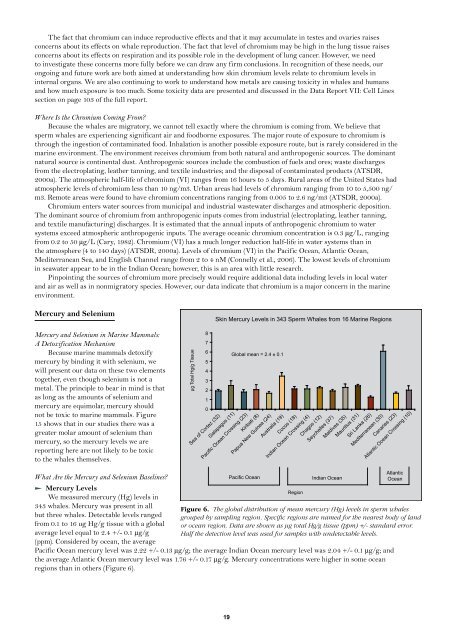Voyage of the Odyssey executive summary - Ocean Alliance
Voyage of the Odyssey executive summary - Ocean Alliance
Voyage of the Odyssey executive summary - Ocean Alliance
You also want an ePaper? Increase the reach of your titles
YUMPU automatically turns print PDFs into web optimized ePapers that Google loves.
The fact that chromium can induce reproductive effects and that it may accumulate in testes and ovaries raises<br />
concerns about its effects on whale reproduction. The fact that level <strong>of</strong> chromium may be high in <strong>the</strong> lung tissue raises<br />
concerns about its effects on respiration and its possible role in <strong>the</strong> development <strong>of</strong> lung cancer. However, we need<br />
to investigate <strong>the</strong>se concerns more fully before we can draw any firm conclusions. In recognition <strong>of</strong> <strong>the</strong>se needs, our<br />
ongoing and future work are both aimed at understanding how skin chromium levels relate to chromium levels in<br />
internal organs. We are also continuing to work to understand how metals are causing toxicity in whales and humans<br />
and how much exposure is too much. Some toxicity data are presented and discussed in <strong>the</strong> Data Report VII: Cell Lines<br />
section on page 103 <strong>of</strong> <strong>the</strong> full report.<br />
Where Is <strong>the</strong> Chromium Coming From?<br />
Because <strong>the</strong> whales are migratory, we cannot tell exactly where <strong>the</strong> chromium is coming from. We believe that<br />
sperm whales are experiencing significant air and foodborne exposures. The major route <strong>of</strong> exposure to chromium is<br />
through <strong>the</strong> ingestion <strong>of</strong> contaminated food. Inhalation is ano<strong>the</strong>r possible exposure route, but is rarely considered in <strong>the</strong><br />
marine environment. The environment receives chromium from both natural and anthropogenic sources. The dominant<br />
natural source is continental dust. Anthropogenic sources include <strong>the</strong> combustion <strong>of</strong> fuels and ores; waste discharges<br />
from <strong>the</strong> electroplating, lea<strong>the</strong>r tanning, and textile industries; and <strong>the</strong> disposal <strong>of</strong> contaminated products (ATSDR,<br />
2000a). The atmospheric half-life <strong>of</strong> chromium (VI) ranges from 16 hours to 5 days. Rural areas <strong>of</strong> <strong>the</strong> United States had<br />
atmospheric levels <strong>of</strong> chromium less than 10 ng/m3. Urban areas had levels <strong>of</strong> chromium ranging from 10 to 5,500 ng/<br />
m3. Remote areas were found to have chromium concentrations ranging from 0.005 to 2.6 ng/m3 (ATSDR, 2000a).<br />
Chromium enters water sources from municipal and industrial wastewater discharges and atmospheric deposition.<br />
The dominant source <strong>of</strong> chromium from anthropogenic inputs comes from industrial (electroplating, lea<strong>the</strong>r tanning,<br />
and textile manufacturing) discharges. It is estimated that <strong>the</strong> annual inputs <strong>of</strong> anthropogenic chromium to water<br />
systems exceed atmospheric anthropogenic inputs. The average oceanic chromium concentration is 0.3 μg/L, ranging<br />
from 0.2 to 50 μg/L (Cary, 1982). Chromium (VI) has a much longer reduction half-life in water systems than in<br />
<strong>the</strong> atmosphere (4 to 140 days) (ATSDR, 2000a). Levels <strong>of</strong> chromium (VI) in <strong>the</strong> Pacific <strong>Ocean</strong>, Atlantic <strong>Ocean</strong>,<br />
Mediterranean Sea, and English Channel range from 2 to 4 nM (Connelly et al., 2006). The lowest levels <strong>of</strong> chromium<br />
in seawater appear to be in <strong>the</strong> Indian <strong>Ocean</strong>; however, this is an area with little research.<br />
Pinpointing <strong>the</strong> sources <strong>of</strong> chromium more precisely would require additional data including levels in local water<br />
and air as well as in nonmigratory species. However, our data indicate that chromium is a major concern in <strong>the</strong> marine<br />
environment.<br />
Mercury and Selenium<br />
Mercury and Selenium in Marine Mammals:<br />
A Detoxification Mechanism<br />
Because marine mammals detoxify<br />
mercury by binding it with selenium, we<br />
will present our data on <strong>the</strong>se two elements<br />
toge<strong>the</strong>r, even though selenium is not a<br />
metal. The principle to bear in mind is that<br />
as long as <strong>the</strong> amounts <strong>of</strong> selenium and<br />
mercury are equimolar, mercury should<br />
not be toxic to marine mammals. Figure<br />
15 shows that in our studies <strong>the</strong>re was a<br />
greater molar amount <strong>of</strong> selenium than<br />
mercury, so <strong>the</strong> mercury levels we are<br />
reporting here are not likely to be toxic<br />
to <strong>the</strong> whales <strong>the</strong>mselves.<br />
What Are <strong>the</strong> Mercury and Selenium Baselines?<br />
l Mercury Levels<br />
We measured mercury (Hg) levels in<br />
343 whales. Mercury was present in all<br />
but three whales. Detectable levels ranged<br />
from 0.1 to 16 ug Hg/g tissue with a global<br />
average level equal to 2.4 +/- 0.1 μg/g<br />
(ppm). Considered by ocean, <strong>the</strong> average<br />
µg Total Hg/g Tissue<br />
8<br />
7<br />
6<br />
5<br />
4<br />
3<br />
2<br />
1<br />
0<br />
Skin Mercury Levels in 343 Sperm Whales from 16 Marine Regions<br />
Pacific <strong>Ocean</strong> mercury level was 2.22 +/- 0.13 μg/g; <strong>the</strong> average Indian <strong>Ocean</strong> mercury level was 2.04 +/- 0.1 μg/g; and<br />
<strong>the</strong> average Atlantic <strong>Ocean</strong> mercury level was 1.76 +/- 0.17 μg/g. Mercury concentrations were higher in some ocean<br />
regions than in o<strong>the</strong>rs (Figure 6).<br />
19<br />
Global mean = 2.4 ± 0.1<br />
Sea <strong>of</strong> Cortez (32)<br />
Galapagos (11)<br />
Pacific <strong>Ocean</strong> Crossing (23)<br />
Kiribati (8)<br />
Papua New Guinea (24)<br />
Australia (19)<br />
Cocos (18)<br />
Indian <strong>Ocean</strong> Crossing (4)<br />
Chagos (12)<br />
Seychelles (37)<br />
Maldives (35)<br />
Mauritius (31)<br />
Sri Lanka (26)<br />
Mediterranean (30)<br />
Canaries (23)<br />
Atlantic <strong>Ocean</strong> Crossing (10)<br />
Pacific <strong>Ocean</strong> Indian <strong>Ocean</strong><br />
Region<br />
Atlantic<br />
<strong>Ocean</strong><br />
Figure 6. The global distribution <strong>of</strong> mean mercury (Hg) levels in sperm whales<br />
grouped by sampling region. Specific regions are named for <strong>the</strong> nearest body <strong>of</strong> land<br />
or ocean region. Data are shown as µg total Hg/g tissue (ppm) +/- standard error.<br />
Half <strong>the</strong> detection level was used for samples with undetectable levels.


